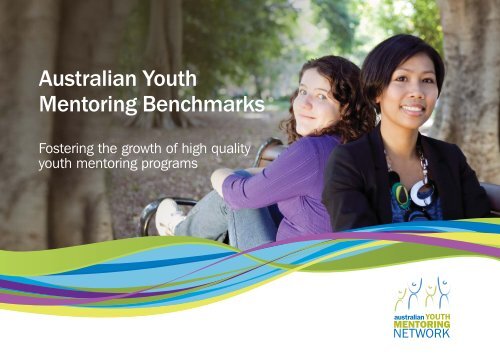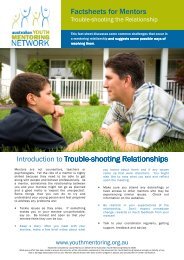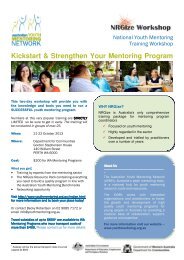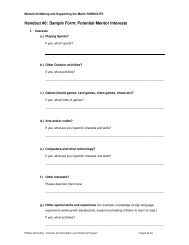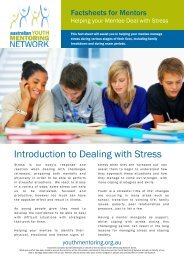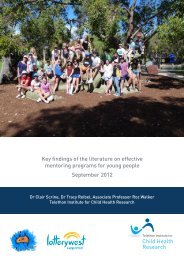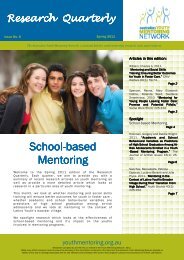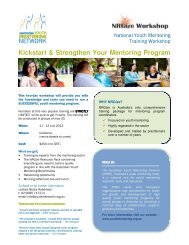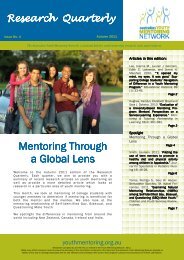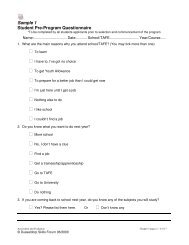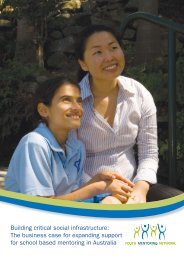to download the Benchmarks (PDF, 2.72 MB). - Australian Youth ...
to download the Benchmarks (PDF, 2.72 MB). - Australian Youth ...
to download the Benchmarks (PDF, 2.72 MB). - Australian Youth ...
- No tags were found...
You also want an ePaper? Increase the reach of your titles
YUMPU automatically turns print PDFs into web optimized ePapers that Google loves.
OverviewMen<strong>to</strong>ring can take many forms, but at its heart lies an affirmation of human relationships. Men<strong>to</strong>ring has <strong>the</strong> capacity <strong>to</strong>enable those involved—both young people and <strong>the</strong>ir men<strong>to</strong>rs—<strong>to</strong> learn and <strong>to</strong> grow.At <strong>the</strong> same time men<strong>to</strong>ring is no soft option.Like any relationship, <strong>the</strong> development of a men<strong>to</strong>ring relationship takes time and commitment. Quality men<strong>to</strong>ring programsrequire hard work and <strong>to</strong>ugh decisions. They require firm undertakings from all involved.Structured men<strong>to</strong>ring programs need <strong>to</strong> be developed and implemented using consistent standards. The effort is worth it.These programs operate with purpose and deliver real outcomes; from raising self-esteem, encouraging healthier behaviours andimproving school attendance, <strong>to</strong> enabling better informed career choices and a more secure place in education or <strong>the</strong> workforce.The first set of benchmarks for Effective and Responsible Men<strong>to</strong>ring Programs were developed in June 2000 when men<strong>to</strong>ringwas a reasonably new strategy in Australia. The benchmarks were updated in 2007 as National <strong>Youth</strong> Men<strong>to</strong>ring <strong>Benchmarks</strong>.This latest edition of <strong>the</strong> benchmarks incorporates what we have learnt over <strong>the</strong> past decade from Australia and overseas.The benchmarks are <strong>the</strong> result of collaboration between a representative group of <strong>Australian</strong> practitioners and researchers.These benchmarks serve as <strong>the</strong> standard that all men<strong>to</strong>ring programs must achieve in order <strong>to</strong> have a strong, successfuland sustainable program. The <strong>Australian</strong> <strong>Youth</strong> Men<strong>to</strong>ring Network encourages all men<strong>to</strong>ring programs <strong>to</strong> achieve <strong>the</strong>sestandards through <strong>the</strong> sharing of resources, professional development and collegial networking.The benchmarks will continue <strong>to</strong> evolve with our collective knowledge and experience. They are offered by <strong>the</strong> <strong>Australian</strong> <strong>Youth</strong>Men<strong>to</strong>ring Network as a fur<strong>the</strong>r contribution <strong>to</strong> <strong>the</strong> development of a collaborative youth men<strong>to</strong>ring community in Australia.
Element 1 Planning and DesignThorough program planning that clearly articulates <strong>the</strong> target group, aims, criteria and model of <strong>the</strong> program.BenchmarkGuidanceChecklistaConsultation with community stakeholders andyoung people where a need for men<strong>to</strong>ring hasbeen identified.• Conduct a community needs assessment.• Ensure young people are actively involved in<strong>the</strong> assessment process.Documentation of interviews/meetings/focus groupswith young people and <strong>the</strong> communityProgram waiting listsbClear vision, mission and values statements.• Ensure <strong>the</strong> vision, mission and values of <strong>the</strong>men<strong>to</strong>ring program is aligned with <strong>the</strong> hos<strong>to</strong>rganisation’s mission and vision.• If <strong>the</strong> men<strong>to</strong>ring program is stand-alone:- develop a vision statement that expresses adesired outcome for <strong>the</strong> young peopleinvolved- develop a mission statement that outlines<strong>the</strong> purpose of <strong>the</strong> program- develop value statements that outline <strong>the</strong>beliefs and principles which will guide <strong>the</strong>program.Vision, mission and values statementscA clear set of aims, objectives and measurableKey Performance Indica<strong>to</strong>rs (KPIs).• Develop a strategic plan or similar documentthat outlines <strong>the</strong> program’s:- aims (what <strong>the</strong> program hopes <strong>to</strong> achieve in<strong>the</strong> longer term)- objectives (specific, measureable,achievable, realistic, time-based)- Key Performance Indica<strong>to</strong>rs (measurableoutcomes and outputs which <strong>the</strong> program isexpected <strong>to</strong> achieve).A strategic plan or similar document outlining <strong>the</strong>aims, objectives and KPIs of <strong>the</strong> programdClear program criteria that identifies <strong>the</strong>:- young people <strong>the</strong> program will serve- men<strong>to</strong>rs that will be required- focus, setting and mode of <strong>the</strong> program• Define <strong>the</strong> youth population <strong>the</strong> program willserve.• Identify target men<strong>to</strong>rs (e.g. senior citizens,corporate employees and university students).Documentation outlining how <strong>the</strong> program willoperate (focus/setting/mode/duration/ frequency/consistency)4 <strong>Australian</strong> <strong>Youth</strong> Men<strong>to</strong>ring <strong>Benchmarks</strong>
Element 1 Planning and DesignThorough program planning that clearly articulates <strong>the</strong> target group, aims, criteria and model of <strong>the</strong> program.Benchmark Guidance Checklist- duration, frequency and consistency of <strong>the</strong>match.• Determine <strong>the</strong> focus of <strong>the</strong> men<strong>to</strong>ringrelationship (e.g. social emotional wellbeing,individual talents and leadership, youth justiceand crime prevention, identity, culture andfaith, and/or education, training andemployment). 1• Choose <strong>the</strong> setting where <strong>the</strong> men<strong>to</strong>ring willtake place. 2• Select <strong>the</strong> mode for how <strong>the</strong> men<strong>to</strong>ring will beconducted.• Determine how long <strong>the</strong> men<strong>to</strong>ring matchesshould continue.• Determine how often men<strong>to</strong>rs and mentees willmeet. 3• Ensure men<strong>to</strong>rs are aware of <strong>the</strong> need <strong>to</strong> beconsistent and reliable in <strong>the</strong>ir approach with<strong>the</strong> young person even if <strong>the</strong> young person<strong>the</strong>mself is not.eA detailed program budget and sustainabilityplan with sufficient income <strong>to</strong> ensure keyelements of program operation are achievable.• Develop a fully costed budget that includesfunds for:- program staff- professional development- operational costs- program activities- program evaluation.• Develop a plan that ensures <strong>the</strong> sustainabilityof <strong>the</strong> program for its intended life cycle. 4Annual budgetsFinancial statementsFunding submissionsSustainability plans1. See page 28 for more information on focus, setting and mode options.2. Ibid.3. The <strong>Australian</strong> <strong>Youth</strong> Men<strong>to</strong>ring Network encourages a minimum one year commitment involving one hour a week. Exceptions <strong>to</strong> this are allowed where a program can demonstrate evidence that <strong>the</strong>re would be a benefit <strong>to</strong> a relationship if <strong>the</strong> relationshipis of shorter duration and contact is less frequent.4. To ensure <strong>the</strong> cost effectiveness of a men<strong>to</strong>ring program <strong>the</strong> <strong>Australian</strong> <strong>Youth</strong> Men<strong>to</strong>ring Network recommends a 3-5 year funding period.youthmen<strong>to</strong>ring.org.au 5
Element 1 Planning and DesignThorough program planning that clearly articulates <strong>the</strong> target group, aims, criteria and model of <strong>the</strong> program.Benchmark Guidance ChecklistfAn advisory group and/or external stakeholderswho provide guidance on program design and<strong>the</strong> ongoing relevance of <strong>the</strong> men<strong>to</strong>ring program.• Ensure young people are actively involved in anadvisory capacity.• Develop <strong>the</strong> terms of reference for <strong>the</strong> advisorygroup that outlines:- roles and responsibilities- group membership- tenure of members of <strong>the</strong> group- grievance resolution and conflict of interestprocedures.• Schedule regular consultations with <strong>the</strong>advisory group and/or external stakeholders.Advisory group terms of referenceMinutes of meetings with advisory groupNotes from discussions with external stakeholders6 <strong>Australian</strong> <strong>Youth</strong> Men<strong>to</strong>ring <strong>Benchmarks</strong>
“Week by week, hour by hourI saw small changes as little by littlehe opened his world up <strong>to</strong> me.”Men<strong>to</strong>r, Department of Educationand Children’s Services SA
Element 2 Management and GovernanceA management and governance structure underpinned by well developed and targeted organisational policies and procedures.Benchmark Guidance ChecklistPOLICIES AND PROCEDURESg A comprehensive set of program operationsand organisational governance andmanagement policies and procedures whichare reviewed every two years.• Develop policies and procedures for programoperations and organisational governance andmanagement.• Ensure that where a program operates withinan existing organisation, existing organisationalpolicies and procedures are modified <strong>to</strong>accommodate <strong>the</strong> specific requirements of <strong>the</strong>men<strong>to</strong>ring program.Program operations policies and proceduresincluding:- Recruitment- Responding <strong>to</strong> inquires- Eligibility- Men<strong>to</strong>r screening and selection- Young person referral and selection- Orientation and training- Matching- Moni<strong>to</strong>ring and supporting- Resolution of match issues- Recognition- Crisis and after-hours support- Closing <strong>the</strong> match- Evaluation- Program closure.Organisational governance and management policiesand procedures including:- Child safety and duty of care- Code of conduct (staff and volunteers)- Critical incidents- Dealing with unacceptable men<strong>to</strong>r behaviour- Employment and industrial issues- Equal opportunity- Grievance- Legal obligations and liability- Insurance (including volunteer insurance)- Media policy- OH&S (including risk assessment)- Overnight visits and out of <strong>to</strong>wn travel- Privacy and confidentiality10 <strong>Australian</strong> <strong>Youth</strong> Men<strong>to</strong>ring <strong>Benchmarks</strong>
Element 2 Management and GovernanceA management and governance structure underpinned by well developed and targeted organisational policies and procedures.Benchmark Guidance Checklist- Record keeping and information management- Reimbursement- Responding <strong>to</strong> young people’s issues andbehaviours- Rights and responsibilities of young people andmen<strong>to</strong>rs- Sexual harassment- Social media usage- Staff training and development- Transportation.youthmen<strong>to</strong>ring.org.au 11
Element 3 EvaluationEvaluation <strong>to</strong> assess <strong>the</strong> impact and effectiveness of <strong>the</strong> program <strong>to</strong> improve its operation and promote its outcomes.Benchmark Guidance ChecklistaA dedicated budget for program evaluation.• Ensure a portion of <strong>the</strong> program operationsbudget is allocated <strong>to</strong> evaluation.A separate item for evaluation in <strong>the</strong> budgetbAn ongoing evaluation strategy identifyingoutcomes at three levels:- effectiveness of program processes- effectiveness of men<strong>to</strong>ring relationships- impact on young people.• Design <strong>the</strong> evaluation strategy before <strong>the</strong>program commences.• Designate a team/person <strong>to</strong> oversee <strong>the</strong>evaluation strategy, process and timeframe.• Design evaluation <strong>to</strong>ols <strong>to</strong> collect dataregarding program operations and outcomes atidentified times.• Design clear processes and procedures <strong>to</strong>effectively collate, analyse and interpret data.An evaluation strategyEvaluation <strong>to</strong>olsEvaluation policy and procedurecCommunication with all stakeholders regardingevidence of program achievements andoutcomes.• Report evaluation results <strong>to</strong> programparticipants, stakeholders and <strong>the</strong> communityso that <strong>the</strong>y are aware of programachievements.Communications strategydProcess of continuous improvement based onevaluation data and feedback.• Ensure <strong>the</strong> program and <strong>the</strong> day <strong>to</strong> dayoperations (e.g. <strong>the</strong> recruitment of men<strong>to</strong>rs,screening, training and support procedures) arerefined in response <strong>to</strong> <strong>the</strong> results of <strong>the</strong>evaluation.Minutes from <strong>the</strong> evaluation and review meetingProgram improvement plansyouthmen<strong>to</strong>ring.org.au 13
Element 4 StaffHigh quality program staff with sufficient resources and support.Benchmark Guidance ChecklistaA staffing and resourcing structure that issufficient for <strong>the</strong> men<strong>to</strong>ring program model andsize.• Ensure staff are supported and resourcedcorrectly by considering fac<strong>to</strong>rs such as <strong>the</strong>number and length of matches, focus, settingand mode of program.• For example a full time coordina<strong>to</strong>r is oftenrequired for ei<strong>the</strong>r:- a community based program supporting 25at risk young people for 12 months viafortnightly meetings with a men<strong>to</strong>r, or- a school based program supporting 50young people for 6 months via weeklymeetings with a men<strong>to</strong>r.Documentation of appropriate resourcing analysisAnnual budgetbRecruitment of skilled and experienced staff <strong>to</strong>manage <strong>the</strong> program.• Develop clear selection criteria <strong>to</strong> recruitprogram management staff with:- appropriate qualifications- strong organisational, written, verbal andinterpersonal skills- experience with young people and anunderstanding of youth issues- experience in program planning anddevelopment and project management.Staff position descriptionsResumes of staffcClearly defined staff roles and responsibilities.• Develop clear staff position descriptions tha<strong>to</strong>utline <strong>the</strong> Key Performance Indica<strong>to</strong>rs for eachrole.Staff position descriptionsKey Performance Indica<strong>to</strong>rs for each roledRelevant induction, training, development,supervision and appraisals given <strong>to</strong> staff <strong>to</strong>support <strong>the</strong>m in <strong>the</strong>ir roles.• Provide a clear induction <strong>to</strong> new staff so that<strong>the</strong>y are prepared for <strong>the</strong> role.• Develop training and development plans foreach staff member.Staff training and development policyIndividual staff training and development plansStaff supervision notesStaff performance/feedback documents14 <strong>Australian</strong> <strong>Youth</strong> Men<strong>to</strong>ring <strong>Benchmarks</strong>
Element 4 StaffHigh quality program staff with sufficient resources and support.Benchmark Guidance Checklist• Ensure staff professional development is builtin<strong>to</strong> <strong>the</strong> operating costs of <strong>the</strong> program.• Provide regular supervision sessions forprogram staff.• Undertake annual performance appraisals forstaff with ongoing skill developmen<strong>to</strong>pportunities based on appraisal outcomes.youthmen<strong>to</strong>ring.org.au 15
Element 5 RecruitmentSuitable men<strong>to</strong>rs and young people recruited from <strong>the</strong> program’s target groups.Benchmark Guidance ChecklistaA planned and targeted recruitment strategythat attracts appropriate men<strong>to</strong>rs who meet <strong>the</strong>needs of <strong>the</strong> program.• Develop a targeted men<strong>to</strong>r recruitment strategythat includes:- identification of targeted men<strong>to</strong>rs- a marketing plan that outlines a variety ofpromotional and recruitment methodsencouraging diversity in recruitment- clear linkages <strong>to</strong> <strong>the</strong> program purpose and<strong>the</strong> needs of young people- program fact/information sheets that clearlystate <strong>the</strong>:• program’s aims• roles, responsibilities and requirementsof men<strong>to</strong>rs and young people in <strong>the</strong>men<strong>to</strong>ring relationship• criteria regarding <strong>the</strong> experience,qualities and characteristics requiredfrom men<strong>to</strong>rs.External communications strategy (including amarketing plan)Program fact/information sheets or similar marketingmaterialMen<strong>to</strong>r role descriptionsbA targeted young person recruitment strategythat informs <strong>the</strong> young person of <strong>the</strong>opportunities provided by <strong>the</strong> program.• Develop a marketing plan that outlines a varietyof promotional and recruitment methodssuitable for <strong>the</strong> target population of youngpeople.• Develop appropriate fact sheets or o<strong>the</strong>rpromotional material that engage young peopleand provide relevant program information.External communications strategy (including amarketing plan)Program fact sheets or similar marketing materialcProvision of information for both men<strong>to</strong>rs andyoung people that clearly outlines <strong>the</strong>expectations of <strong>the</strong> men<strong>to</strong>ring relationship.• Develop and provide clear information aboutwhat is required in <strong>the</strong> men<strong>to</strong>ring relationship(e.g. frequency and duration of contact, privacyand confidentiality and match closureprocedure).Men<strong>to</strong>r position descriptionsYoung person role descriptionsCode of conduct16 <strong>Australian</strong> <strong>Youth</strong> Men<strong>to</strong>ring <strong>Benchmarks</strong>
Element 5 RecruitmentSuitable men<strong>to</strong>rs and young people recruited from <strong>the</strong> program’s target groups.Benchmark Guidance ChecklistdA process for <strong>the</strong> referral and/or application ofyoung people <strong>to</strong> <strong>the</strong> program.• Establish a clear process for referral/applicationof young people that takes in<strong>to</strong> account <strong>the</strong>young person’s needs and suitability for <strong>the</strong>program.• Develop a referral form and application formthat collects information that assists:- in assessing a young person’s suitability for<strong>the</strong> program- in understanding <strong>the</strong> young person’s goalsand interests- with matching <strong>the</strong> young person with anappropriate men<strong>to</strong>r.• Ensure that only information that is relevant <strong>to</strong><strong>the</strong> men<strong>to</strong>ring function is collected <strong>to</strong> avoid anybreach of privacy.Young person referral formsYoung person application formsHealth and medical consent formsRelevant notes from discussions between programstaff and referring agenciesyouthmen<strong>to</strong>ring.org.au 17
Element 6 Selection and ScreeningA clear selection process <strong>to</strong> assess <strong>the</strong> suitability of men<strong>to</strong>rs and young people.Benchmark Guidance ChecklistSELECTION AND SCREENING OF MENTORSa Formal selection criteria for determining amen<strong>to</strong>r’s suitability for <strong>the</strong> role.• Develop clear selection criteria on which <strong>to</strong>base decisions for assessing <strong>the</strong> suitability ofpotential men<strong>to</strong>rs.Clear selection criteria for men<strong>to</strong>rsbA formal men<strong>to</strong>r application process including<strong>the</strong> applicant’s response <strong>to</strong> <strong>the</strong> selectioncriteria.• Develop a clear application form that collectsinformation that will assist in assessing anapplicant’s suitability for <strong>the</strong> program.• Ensure only information that is relevant <strong>to</strong> <strong>the</strong>men<strong>to</strong>ring role is collected <strong>to</strong> avoid any breachof privacy.Men<strong>to</strong>r application formcA well documented men<strong>to</strong>r selection processwhich involves more than one person indecision making and includes:- an interview- two reference checks- 100 point ID check- national criminal his<strong>to</strong>ry check- state and terri<strong>to</strong>ry Working with ChildrenChecks (where young people are under 18years)- at least one instance of face <strong>to</strong> face contactwith program staff, prior <strong>to</strong> final selection.• Assess <strong>the</strong> potential men<strong>to</strong>r’s suitability against<strong>the</strong> selection criteria.• Ensure face <strong>to</strong> face interviews occur for allmen<strong>to</strong>rs who may be working with at risk youngpeople.• Ensure a minimum of one instance of face <strong>to</strong>face contact with program staff (e.g. trainingsessions) where an interview cannot beconducted face <strong>to</strong> face.Criminal his<strong>to</strong>ry check applicationsReference check resultsCopies of <strong>the</strong> 100 point ID checkState and terri<strong>to</strong>ry child protection safety checksMen<strong>to</strong>r interview notesNotes from discussions between selection panelDocumentation of reasons why applicant wasunsuccessful—including potential ‘red flags’ orconcernsdPolicies and procedures for determining andinforming successful and unsuccessful men<strong>to</strong>rapplicants.• Ensure clear verbal and written communicationwith applicants outlining whe<strong>the</strong>r or not <strong>the</strong>yhave been successful.• Develop a process for referring unsuccessfulapplicants <strong>to</strong> o<strong>the</strong>r relevant volunteeringopportunities (where appropriate).Eligibility policy outlining <strong>the</strong> procedure <strong>to</strong> be usedfor unsuccessful applicantsLetter informing successful or unsuccessfulapplicants18 <strong>Australian</strong> <strong>Youth</strong> Men<strong>to</strong>ring <strong>Benchmarks</strong>
Element 7 Orientation and TrainingComprehensive orientation and training for men<strong>to</strong>rs and young people <strong>to</strong> assist <strong>the</strong>m in building an effective men<strong>to</strong>ring relationship.Benchmark Guidance ChecklistORIENTATION AND TRAINING OF MENTORSa Men<strong>to</strong>rs receive appropriate preparation forparticipation in men<strong>to</strong>ring, including trainingand resources <strong>to</strong> enable <strong>the</strong>m <strong>to</strong> perform <strong>the</strong>irrole. Topics must include:- definitions/understanding of men<strong>to</strong>ring- roles, responsibilities, expectations andboundaries of <strong>the</strong> relationship- communication skills, including conflictmanagement- confidentiality and risk management issuesrelevant <strong>to</strong> participants- developing and implementing culturallyappropriate practices.ORIENTATION OF YOUNG PEOPLEb Young people receive appropriate preparationfor participation in men<strong>to</strong>ring. Topics mustinclude:- definitions/understanding of men<strong>to</strong>ring- roles, responsibilities, expectations andboundaries of <strong>the</strong> relationship- confidentiality and o<strong>the</strong>r relevant issues- how <strong>the</strong> young person will communicatewith o<strong>the</strong>r parties involved in <strong>the</strong> programincluding program staff and men<strong>to</strong>rs- how program staff will communicate withmen<strong>to</strong>rs, teachers, case managers andparents/guardians about <strong>the</strong> young personinvolved in <strong>the</strong> program.• Provide sufficient time for men<strong>to</strong>rs <strong>to</strong> gainan adequate understanding of men<strong>to</strong>ring.Pre-match training should not be less than sixhours. 5• Ensure training is practical and goal-orientated,grounded in <strong>the</strong> learners’ experiences andsupportive, not competitive.• Ensure trained men<strong>to</strong>rs demonstrate a clearunderstanding of men<strong>to</strong>ring and how <strong>to</strong> buildan effective men<strong>to</strong>ring relationship. This couldbe demonstrated via assessing volunteers while<strong>the</strong>y discuss likely scenarios during training orvia pre and post training surveys or miniknowledge ‘tests’.• Ensure <strong>the</strong> format of orientation is appropriatefor <strong>the</strong> young people in <strong>the</strong> program. This mayoccur through a group orientation session orthrough an individual session with programstaff.• Ensure young people are made aware of <strong>the</strong>irrights in <strong>the</strong> men<strong>to</strong>ring relationship, includingwhere <strong>the</strong>y can go <strong>to</strong> seek support if <strong>the</strong>re isan issue.• Confirm and discuss <strong>the</strong> goals and interestsidentified in <strong>the</strong> young person’s referral and/orapplication form.Training agendasMen<strong>to</strong>r pre and post training survey resultsMen<strong>to</strong>ring training course contentMen<strong>to</strong>r training handbooks/handoutsAttendance records at training sessionsTraining/orientation manualsHandouts for <strong>the</strong> young personAttendance records at training sessionsResolution of match issues policy and procedures20 <strong>Australian</strong> <strong>Youth</strong> Men<strong>to</strong>ring <strong>Benchmarks</strong>
Element 7 Orientation and TrainingComprehensive orientation and training for men<strong>to</strong>rs and young people <strong>to</strong> assist <strong>the</strong>m in building an effective men<strong>to</strong>ring relationship.Benchmark Guidance ChecklistcOrientation and training is evaluated andimprovements made.• Encourage feedback from young people andmen<strong>to</strong>rs <strong>to</strong> ensure ongoing relevance oforientation and training.• Revise training and resources in response <strong>to</strong>feedback and any changes <strong>to</strong> men<strong>to</strong>ringpractice and/or legislation.Copies of completed evaluation forms/surveysNotes from feedback discussions/focus groups withyoung people and men<strong>to</strong>rs5. As recommended by Rhodes, J. (2001) ‘<strong>Youth</strong> Men<strong>to</strong>ring in Perspective’, The Centre Summer.youthmen<strong>to</strong>ring.org.au 21
“Amanda never judges me or makes me feelthat my problems are silly. She is not just mymen<strong>to</strong>r she is my friend.” Mentee, Sydney NSW
Element 8 Making <strong>the</strong> MatchA consistent matching process that links <strong>the</strong> young person with <strong>the</strong> most appropriate men<strong>to</strong>r.Benchmark Guidance ChecklistaThe matching process focuses on <strong>the</strong> needs of<strong>the</strong> young person and considers:- <strong>the</strong> relevant characteristics, skills andinterests of <strong>the</strong> men<strong>to</strong>r- <strong>the</strong> relevant characteristics, skills andinterests of <strong>the</strong> young person.• Tailor matching criteria <strong>to</strong> prioritise <strong>the</strong> youngperson. Consider:- <strong>the</strong> preferences and goals of <strong>the</strong> youngperson, men<strong>to</strong>r and <strong>the</strong>ir parent or guardian(where appropriate)- <strong>the</strong> men<strong>to</strong>r’s experience/skills/expertise- o<strong>the</strong>r shared interests between <strong>the</strong> men<strong>to</strong>rand young person- similarity of personalities and temperamentsbetween <strong>the</strong> men<strong>to</strong>r and <strong>the</strong> young person- gender or ethnicity, if <strong>the</strong>se are important <strong>to</strong><strong>the</strong> young person- any special needs of <strong>the</strong> young person- geographic closeness and compatibility ofmeeting times.Matching criteriaMatching policy and proceduresbAn official agreement from <strong>the</strong> men<strong>to</strong>r andyoung person on <strong>the</strong> terms and conditions of<strong>the</strong> men<strong>to</strong>ring relationship.• Confirm and gain agreement on <strong>the</strong> roles,responsibilities and expectations of men<strong>to</strong>rs,young people and program staff.Match agreementSigned copies of <strong>the</strong> code of conductcKey stakeholders are aware of and support <strong>the</strong>terms and conditions of <strong>the</strong> men<strong>to</strong>ringrelationship.• Brief key stakeholders (e.g. parents, guardians,case managers and teachers) <strong>to</strong> address <strong>the</strong>irconcerns and encourage <strong>the</strong>ir support of <strong>the</strong>men<strong>to</strong>ring relationship.• Ensure stakeholders are aware of <strong>the</strong> roles andresponsibilities of program staff.• Ensure stakeholders are aware of <strong>the</strong>ir rolesand responsibilities.Match agreementLetter or o<strong>the</strong>r documentation outlining terms andconditions of <strong>the</strong> match and <strong>the</strong> role andresponsibilities of <strong>the</strong> program and stakeholdersyouthmen<strong>to</strong>ring.org.au 23
Element 9 Moni<strong>to</strong>ring and SupportOngoing match support including regular moni<strong>to</strong>ring and feedback <strong>to</strong> manage risk and create opportunities <strong>to</strong> celebrate <strong>the</strong> relationship.Benchmark Guidance ChecklistMONITORINGa Program staff moni<strong>to</strong>r <strong>the</strong> contact madebetween <strong>the</strong> young person and men<strong>to</strong>r and <strong>the</strong>progress of <strong>the</strong> men<strong>to</strong>ring relationship.• Develop a clear policy and procedure <strong>to</strong>moni<strong>to</strong>r and respond <strong>to</strong> match developments.• Ensure program staff contact both <strong>the</strong> youngperson and <strong>the</strong> men<strong>to</strong>r no less than fortnightlyin <strong>the</strong> first three months of <strong>the</strong> relationship andmonthly <strong>the</strong>reafter.• Ensure arrangements are in place <strong>to</strong> moni<strong>to</strong>rand support young people where <strong>the</strong> programmodel does not allow for direct contact withyoung people (e.g. when school staff areresponsible for contact). Any issues that arisein <strong>the</strong> relationship must be communicated <strong>to</strong><strong>the</strong> program staff.Match support policy and proceduresCommunication logs (record of contact betweenmen<strong>to</strong>ring matches)Case notesbProgress data is recorded <strong>to</strong> provide usefulinformation about <strong>the</strong> ongoing development of<strong>the</strong> match.• Ensure data is s<strong>to</strong>red in a manageablerecording system (e.g. database, progress logor case notes).• Use <strong>the</strong> database <strong>to</strong> moni<strong>to</strong>r <strong>the</strong> progress of<strong>the</strong> match in order <strong>to</strong> provide tailored support<strong>to</strong> <strong>the</strong> participants.Progress databaseMatch progress logCase notescProgress of <strong>the</strong> match is communicated <strong>to</strong>stakeholders in accordance with informationmanagement and confidentiality policies.• Clearly define with whom information is shared,what information is shared and for whatpurpose it is shared.Record keeping and information management policyand proceduresPrivacy and confidentiality policy and proceduresEmails, letters and o<strong>the</strong>r documentation sharinginformation with stakeholdersNotes from briefing meetings with key stakeholders24 <strong>Australian</strong> <strong>Youth</strong> Men<strong>to</strong>ring <strong>Benchmarks</strong>
Element 10 Closing <strong>the</strong> matchA planned end <strong>to</strong> <strong>the</strong> formal relationship that is clearly agreed and adhered <strong>to</strong> by all stakeholders.Benchmark Guidance ChecklistaA formal match closure policy and procedurewith clear procedures for exiting <strong>the</strong> programand guidelines regarding future contactbetween <strong>the</strong> men<strong>to</strong>r and young person.• Ensure <strong>the</strong> policy and procedure caters forwhen:- a relationship reaches <strong>the</strong> end of <strong>the</strong> setmen<strong>to</strong>ring period- a relationship is terminated early by ei<strong>the</strong>r<strong>the</strong> young person or men<strong>to</strong>r- a relationship must be terminated by <strong>the</strong>program due <strong>to</strong> a breach of program policy- a young person and/or men<strong>to</strong>r whose priorrelationship has ended wishes <strong>to</strong> berematched in <strong>the</strong> program- a young person and/or men<strong>to</strong>r is unavailable<strong>to</strong> complete exit interviews or finalevaluations.• Ensure <strong>the</strong> men<strong>to</strong>r and young person agreeupon and understand <strong>the</strong> nature andboundaries of any ongoing relationship outsideof <strong>the</strong> program.• Conduct exit interviews or final evaluations withall men<strong>to</strong>rs, young people and key stakeholders(e.g. parents, guardians, case managers andteachers) (where appropriate) regarding <strong>the</strong>irexperiences in <strong>the</strong> program.• Notify all key stakeholders of <strong>the</strong> closure of <strong>the</strong>match and any intention by <strong>the</strong> young personand <strong>the</strong> men<strong>to</strong>r of ongoing contact.• Provide a copy of <strong>the</strong> closing <strong>the</strong> match policyand procedure <strong>to</strong> all key stakeholders <strong>to</strong> ensureclarity around <strong>the</strong> ongoing role of <strong>the</strong> program.Closing <strong>the</strong> match policy and procedureMinutes from exit interviews or debriefing sessionsFinal evaluation formsLetters <strong>to</strong> stakeholders regarding match closure26 <strong>Australian</strong> <strong>Youth</strong> Men<strong>to</strong>ring <strong>Benchmarks</strong>
DefinitionsFocus AreasSocial and emotional wellbeingMen<strong>to</strong>ring <strong>to</strong> assist young people <strong>to</strong> increase <strong>the</strong>irself-esteem, self-efficacy and resilience by activelysupporting <strong>the</strong>ir social and emotional wellbeing.The focus includes improving both <strong>the</strong> youngperson’s life skills and <strong>the</strong> positive connections<strong>the</strong>y have with <strong>the</strong>ir community.Individual talents and leadershipMen<strong>to</strong>ring <strong>to</strong> assist young people <strong>to</strong> fur<strong>the</strong>r develop<strong>the</strong>ir individual talents and/or leadership skills in aspecific area (e.g. sports, pho<strong>to</strong>graphy, drama) inorder for <strong>the</strong>m <strong>to</strong> reach <strong>the</strong>ir full potential.Identity, culture and faithMen<strong>to</strong>ring <strong>to</strong> assist young people <strong>to</strong> grow in <strong>the</strong>irunderstanding of <strong>the</strong>ir faith and/or culture andcultural identity. The program actively supportsyoung people <strong>to</strong> be proud and confident of <strong>the</strong>iridentity and culture and <strong>to</strong> be able <strong>to</strong> exercise thisin <strong>the</strong>ir community.<strong>Youth</strong> justice and crime preventionMen<strong>to</strong>ring <strong>to</strong> assist young people <strong>to</strong> avoid antisocialand offending behaviours by encouragingconnectedness with positive elements in <strong>the</strong>ircommunity and increasing protective fac<strong>to</strong>rs.ModeMethod of deliveryFACE TO FACEThe men<strong>to</strong>ring sessions are held in person,face <strong>to</strong> face.E-MENTORINGElectronic men<strong>to</strong>ring uses technology <strong>to</strong>connect <strong>the</strong> men<strong>to</strong>r with <strong>the</strong> young person.This can be text based or utilising Voice overIP (Internet Pro<strong>to</strong>col) and video technology.RelationshipONE TO ONEOne men<strong>to</strong>r matched with one young person.GROUPOne men<strong>to</strong>r matched with up <strong>to</strong> four youngpeople (If <strong>the</strong> ratio is greater than 1:4, this isno longer considered quality men<strong>to</strong>ring 6 ).TEAMTwo or more men<strong>to</strong>rs matched with oneyoung person.SettingsSchoolMen<strong>to</strong>ring occurs on <strong>the</strong> school premises.CommunityMen<strong>to</strong>ring occurs within <strong>the</strong> local community,utilising community spaces such as parks, cafés,libraries etc.WorkplaceMen<strong>to</strong>ring occurs on <strong>the</strong> business premises.O<strong>the</strong>r SiteMen<strong>to</strong>ring occurs in o<strong>the</strong>r site based locationsincluding but not limited <strong>to</strong> universities, juvenilejustice centres, youth centres, football clubs etc.Education, training and employmentMen<strong>to</strong>ring <strong>to</strong> assist young people <strong>to</strong> positivelyengage in and maintain <strong>the</strong>ir participation ineducation, training and employment. Theseprograms assist young people <strong>to</strong> develop a visionfor <strong>the</strong>ir future and provide support <strong>to</strong> achieve <strong>the</strong>ireducation, training and career goals.6 Rhodes, J.E. (2002). Stand by me: The risks and rewards of men<strong>to</strong>ring <strong>to</strong>day’s youth. Cambridge, MA: Harvard University PressGrossman.J.B and Bulle B.A (2006) Review of what youth programs do <strong>to</strong> increase <strong>the</strong> connectedness of youth with adults, Journal ofAdolescent Heath, Vol39, pg. 788-799Rhodes. J.E and Dubois, D.L (2006) Understanding and facilitating <strong>the</strong> youth men<strong>to</strong>ring movement; Social Policy Report v20, no.328 <strong>Australian</strong> <strong>Youth</strong> Men<strong>to</strong>ring <strong>Benchmarks</strong>
ModelsThere is no one size fits all modelMen<strong>to</strong>ring is flexible and can and should be tailored <strong>to</strong> suit <strong>the</strong> individual needs of <strong>the</strong> young people who will be involved in <strong>the</strong> program. What works for one communitymay not work for <strong>the</strong> next and so an assessment of <strong>the</strong> community’s needs must take place <strong>to</strong> ensure <strong>the</strong> program is what <strong>the</strong> young people want and that it can besupported by <strong>the</strong> community.Tips for choosing <strong>the</strong> right model for your communityFocus – Your program can have more than one focus. The focus areas you choose should align with <strong>the</strong> outcomes you are trying <strong>to</strong> achieve.Mode – Some programs may choose <strong>to</strong> use a combination of Face <strong>to</strong> Face and E-men<strong>to</strong>ring for <strong>the</strong>ir matches.Setting – Complete a separate risk assessment for each setting that you choose as <strong>the</strong>y may impact on operational aspects of <strong>the</strong> program such as screening,moni<strong>to</strong>ring and support. They may also have fur<strong>the</strong>r implications on policies and procedures.STEP ONE: FOCUSDetermine <strong>the</strong> focusfor your programSelect adelivery methodSTEP TWO: MODESelect arelationshipSTEP THREE: SETTINGChoose <strong>the</strong> setting for<strong>the</strong> men<strong>to</strong>ring sessionsSocial, Emotional WellbeingFace <strong>to</strong> FaceOne <strong>to</strong> OneSchoolIndividual Talents and LeadershipE-men<strong>to</strong>ringGroupCommunity<strong>Youth</strong> Justice and Crime PreventionTeamWorkplaceIdentity, Culture and FaithO<strong>the</strong>r SiteEducation, Training and Employmentyouthmen<strong>to</strong>ring.org.au 29
GlossaryVision: an ideal or a desired outcome for <strong>the</strong> young people involved in <strong>the</strong> program.Mission statement: a short statement that outlines <strong>the</strong> overall purpose of <strong>the</strong>program – what <strong>the</strong> program does and for whom.Values: a statement that outlines <strong>the</strong> beliefs and principles which will guide <strong>the</strong>program.Aims: what <strong>the</strong> program hopes <strong>to</strong> achieve in <strong>the</strong> longer term.Objectives: <strong>the</strong> specific targets that need <strong>to</strong> be achieved <strong>to</strong> realise <strong>the</strong> mission.Objectives should be SMART (specific, measureable, achievable, realistic, timebased).Action Plan: a prioritised list of tasks designed <strong>to</strong> achieve <strong>the</strong> aims and objectivesof <strong>the</strong> program. An action plan includes responsibilities, timeframes andperformance indica<strong>to</strong>rs.Key Performance Indica<strong>to</strong>rs: measurable outcomes and outputs which <strong>the</strong>program and/ or staff are expected <strong>to</strong> achieve.Stakeholders: <strong>the</strong> people or groups who have an interest in <strong>the</strong> program(e.g. parents, guardians, case managers, teachers, community partners andfunders).Advisory group: a collection of individuals who bring unique knowledge and skillswhich complement <strong>the</strong> knowledge and skills of <strong>the</strong> formal governance groupmembers and/or staff in order <strong>to</strong> more effectively support <strong>the</strong> program. The advisorygroup is generally limited <strong>to</strong> making recommendations and/or providing backgroundfor governance group decisions. The advisory group may also play a public relationsrole by bringing in contacts <strong>to</strong> support <strong>the</strong> program.
<strong>Australian</strong> <strong>Youth</strong> Men<strong>to</strong>ring Benchmark Review PanelTom AndrewsProgram Direc<strong>to</strong>r, Assistant<strong>Australian</strong> Indigenous Men<strong>to</strong>ring Experience (AIME)Amy BeattyMen<strong>to</strong>r and Support Services Manager<strong>Youth</strong> Futures WATrent HarvisonConnect2Men<strong>to</strong>ring Coordina<strong>to</strong>rUnited SynergiesSarah JohnsonExecutive OfficerVic<strong>to</strong>rian <strong>Youth</strong> Men<strong>to</strong>ring AllianceJessica JonesNational Operations & Support ManagerBig Bro<strong>the</strong>rs Big Sisters AustraliaDr Judith MacCallumDean of School of EducationMurdoch UniversityMichael OrmsbyVolunteer Relationship Coordina<strong>to</strong>r -Sou<strong>the</strong>rn NSW & ACTThe Smith FamilyJacqui PinkavaProject Officer<strong>Youth</strong> Attainment and Transitions BranchDepartment of Education Employmentand Workplace RelationsDr Peter ReynoldsManager WA <strong>Youth</strong> Men<strong>to</strong>ring Reforms Children EarlyYears, <strong>Youth</strong> and FamiliesWA Department of CommunitiesAllison TrethowanProgram Manager Men<strong>to</strong>ringWhitelion IncKathleen VellaExecutive Officer<strong>Australian</strong> <strong>Youth</strong> Men<strong>to</strong>ring NetworkDavid WhiteChairperson<strong>Australian</strong> <strong>Youth</strong> Men<strong>to</strong>ring NetworkRichard WundkeE-men<strong>to</strong>ring Program ManagerSA Department for Education and Child DevelopmentAcknowledgementsThe <strong>Australian</strong> <strong>Youth</strong> Men<strong>to</strong>ring Network gratefully recognises <strong>the</strong> contributions from <strong>the</strong> many people and organisationsthat provided feedback during <strong>the</strong> consultation process for this document.We also wish <strong>to</strong> acknowledge and thank Ian Colley from Make Stuff Happen, Rebecca Hanlon and Michelle Smart fromGood with Words, and Sarah Johnson from Vic<strong>to</strong>rian <strong>Youth</strong> Men<strong>to</strong>ring Alliance for <strong>the</strong>ir assistance with <strong>the</strong> review and <strong>to</strong>Kathleen Vella from <strong>Australian</strong> <strong>Youth</strong> Men<strong>to</strong>ring Network for leading <strong>the</strong> project.youthmen<strong>to</strong>ring.org.au 31
Complete <strong>the</strong> AYMN Online Self Assessment Tool (OSAT)OSAT is designed <strong>to</strong> assist youth men<strong>to</strong>ringprograms <strong>to</strong> identify how well <strong>the</strong>y aremeeting <strong>the</strong> <strong>Australian</strong> <strong>Youth</strong> Men<strong>to</strong>ring<strong>Benchmarks</strong> and help understand where <strong>the</strong>program’s strengths and weaknesses lie.By completing this <strong>to</strong>ol you will be able <strong>to</strong> see:1 How healthy your program is and what makesa quality men<strong>to</strong>ring program2 Areas in your program that are tracking well orneed improvement3 How your program rates against <strong>the</strong> averageof all o<strong>the</strong>r programs that have completed <strong>the</strong><strong>to</strong>ol4 Useful links and resources for continuousimprovementThis is an anonymous process and only <strong>the</strong>program staff completing <strong>the</strong> <strong>to</strong>ol will be able <strong>to</strong>see <strong>the</strong>ir individual results.How <strong>to</strong> use OSATSTEP 1Login at youthmen<strong>to</strong>ring.org.au using your AYMNuser name and password• If your program is not yet registered simplyadd your program <strong>to</strong> <strong>the</strong> National <strong>Youth</strong>Men<strong>to</strong>ring Database on <strong>the</strong> AYMN websiteSTEP 2Complete <strong>the</strong> Assessment• Answer <strong>the</strong> questions in each sectionusing a simple 0-5 rating; 0 being notapplicable, 1 being rarely and 5 beingalways.• The complete assessment takes at most60 minutes but...if you need <strong>to</strong> s<strong>to</strong>p andsave your work, click Save and ContinueLater and when you next login <strong>the</strong> systemwill pick up where you left off.• When you have answered all <strong>the</strong>questions, click Submit Assessment <strong>to</strong>au<strong>to</strong>matically generate your reports.STEP 3View Your ReportsThere are four different types of reports generated:1 Quick View Status Report – provides yourprogram’s average score for each benchmarkelement.2 Report Against all Indica<strong>to</strong>rs –provides youwith your individual scores for eachbenchmark indica<strong>to</strong>rs.3 Your rating against average rating of allprograms registered – shows your ratingagainst <strong>the</strong> average of all programs that haveregistered and completed <strong>the</strong>ir assessment(anonymity preserved).4 Your Program’s Strengths and Weaknesses -a priority list that shows your program’sstrengths and weaknesses, by ga<strong>the</strong>ring all<strong>the</strong> indica<strong>to</strong>rs under whichever rating you’vegiven <strong>the</strong>m from 0 – 5.You can return and do <strong>the</strong> assessment as manytimes as you wish.32 <strong>Australian</strong> <strong>Youth</strong> Men<strong>to</strong>ring <strong>Benchmarks</strong>
Be part of Australia’smen<strong>to</strong>ring network,get connected,be supportedJoin <strong>the</strong> AYMNe-newsletterand never miss ou<strong>to</strong>n <strong>the</strong> latest news!Register your programfor FREE on <strong>the</strong>National <strong>Youth</strong>Men<strong>to</strong>ring DatabaseRaise your program’s profileand gain access <strong>to</strong> resourceson <strong>the</strong> AYMN website onlyavailable <strong>to</strong> registeredprograms with a usernameand passwordUpgrade your free membership <strong>to</strong> a paid membershipand start accessing The Toolbox and Evidence BankTHE TOOLBOXAccess sample forms, policies, procedures andmany resources <strong>to</strong> help set up your program.THE EVIDENCE BANKLooking for men<strong>to</strong>ring research on specific <strong>to</strong>pic?Search The Evidence Bank via keywords, benchmarkcategories or authors.Using your AYMN usernameand password programsau<strong>to</strong>matically get access <strong>to</strong>OSAT and <strong>the</strong> OnlineCommunityOnline SelfAssessment ToolCheck <strong>to</strong> see how well yourprogram is meeting <strong>the</strong><strong>Australian</strong> <strong>Youth</strong> Men<strong>to</strong>ring<strong>Benchmarks</strong>.AYMN OnlineCommunityBuilt <strong>to</strong> bring people<strong>to</strong>ge<strong>the</strong>r, <strong>to</strong> connectand communicate.visit youthmen<strong>to</strong>ring.org.au
<strong>Australian</strong> <strong>Youth</strong> Men<strong>to</strong>ring NetworkLevel 9117 Clarence StreetSydney NSW 2000AustraliaFor fur<strong>the</strong>r information on youth men<strong>to</strong>ring in Australiavisit <strong>the</strong> <strong>Australian</strong> <strong>Youth</strong> Men<strong>to</strong>ring Network website youthmen<strong>to</strong>ring.org.au


